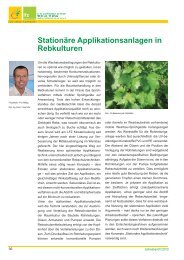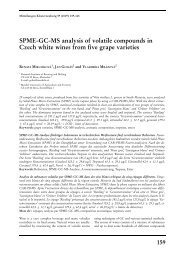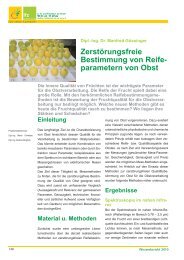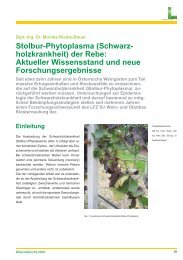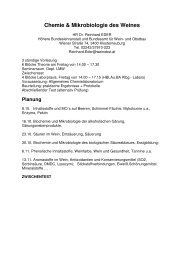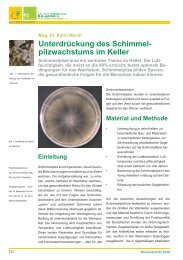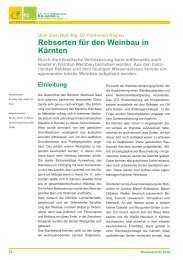Polyphenolic composition of German white wines and its use for the ...
Polyphenolic composition of German white wines and its use for the ...
Polyphenolic composition of German white wines and its use for the ...
You also want an ePaper? Increase the reach of your titles
YUMPU automatically turns print PDFs into web optimized ePapers that Google loves.
Mitteilungen Klosterneuburg 57 (2007): 146-152 Pour Nikfardjam et al.<br />
Figure 1: PCA <strong>of</strong> 'MuÈ ller-Thurgau' <strong>and</strong> 'Silvaner' <strong>for</strong> 7 polyphenols<br />
This shows, in accordance with RITTER (1994) <strong>and</strong> POUR<br />
NIKFARDJAM (2001), that caftaric acid is very prone to<br />
oxidative processes <strong>and</strong> is probably lost intensively<br />
through enzymatic or chemical reactions with glutathion<br />
to GRP during vinification. Also <strong>the</strong> oxidatively<br />
derived polyphenol tyrosol has a strong influence on<br />
<strong>the</strong> polyphenolic fingerprint. In fact, tyrosol is <strong>of</strong>ten<br />
much more dominant in <strong>German</strong> <strong>wines</strong> than caftaric<br />
acid <strong>and</strong> indicates <strong>the</strong> relatively oxidative h<strong>and</strong>ling <strong>of</strong><br />
grapes <strong>and</strong> wine (POUR NIKFARDJAM, 2001) <strong>the</strong>reby supporting<br />
<strong>the</strong> assumption that hydroxybenzoic <strong>and</strong> hydroxycinnamic<br />
acid concentrations decrease during vinification<br />
- mainly through oxidation <strong>and</strong> fining.<br />
Although PCA is a good statistical method to explain<br />
dependencies between polyphenolic compounds in <strong>the</strong><br />
two <strong>white</strong> cultivars 'MuÈ ller-Thurgau' <strong>and</strong> 'Silvaner', it<br />
cannot be <strong>use</strong>d to distinguish between cultivars according<br />
to <strong>the</strong>ir polyphenolic <strong>composition</strong>. Varietal as<br />
well as oenological <strong>and</strong> seasonal influences seem to affect<br />
<strong>the</strong> polyphenolic <strong>composition</strong> <strong>of</strong> <strong>white</strong> <strong>wines</strong> too<br />
strongly. There<strong>for</strong>e, <strong>the</strong> ratio between two polyphenols<br />
cannot be expected to remain constant as known <strong>for</strong><br />
red cultivars <strong>and</strong> <strong>the</strong>ir anthocyanin <strong>composition</strong> (EDER<br />
et al., 1996).<br />
So <strong>the</strong>se results are in opposition to <strong>the</strong> data recently<br />
published by DE VILLIERS et al. (2005). According to<br />
<strong>the</strong>ir results, 97.4% <strong>of</strong> <strong>the</strong> <strong>wines</strong> made from <strong>white</strong><br />
grape cultivars could be correctly classified on basis <strong>of</strong><br />
<strong>the</strong>ir polyphenolic pr<strong>of</strong>ile. O<strong>the</strong>r recently published<br />
methods, such as FTIR techniques, have also been successfully<br />
<strong>use</strong>d <strong>for</strong> <strong>the</strong> discrimination <strong>of</strong> red wine cultivars<br />
(EDELMANN et al., 2001; PICQUE et al., 2002). There<strong>for</strong>e,<br />
research should focus on <strong>the</strong>se techniques <strong>and</strong> test<br />
<strong>the</strong>ir possible application <strong>for</strong> <strong>the</strong> identification <strong>of</strong> <strong>white</strong><br />
wine cultivars.<br />
References<br />
BOURSIQUOT, J.M. (1987): Contribution aÁ l'eÂtude des esters hydroxycinnamoyltartriques<br />
chez le genre Vitis: ReÂcherche<br />
d'application taxonomique. - Montpellier: TheÁse Doct.<br />
Ing. ENSA, 1987<br />
DIETRICH, H., PATZ C.-D., POUR-NIKFARDJAM, M., HOFFMANN,<br />
D., GREINER, D. und BAUER, K.-H. 2004: Chemische Charakterisierung<br />
von Weinen der Sorte Riesling der Jahre<br />
1892-1921 aus dem Rheingau. Mitt. Klosterneuburg 54:<br />
222-233<br />
DE VILLIERS, A., MAJEK, P., LYNEN, F., CROUCH, A., LAUER, H.<br />
<strong>and</strong> SANDRA, P. 2005: Classification <strong>of</strong> South African red<br />
<strong>and</strong> <strong>white</strong> <strong>wines</strong> according to grape cultivar based on<br />
<strong>the</strong> non-coloured phenolic content. Eur. Food Res.<br />
Technol. 221(3/4): 520-528<br />
EDELMANN, A., DIEWOK, J., SCHUSTER, K.C. <strong>and</strong> LENDL, B. 2001:<br />
Rapid method <strong>for</strong> <strong>the</strong> discrimination <strong>of</strong> red wine cultivars<br />
based on mid-infrared spectroscopy <strong>of</strong> phenolic<br />
wine extracts. J. Agric. Food Chem. 49: 1139-45<br />
151



